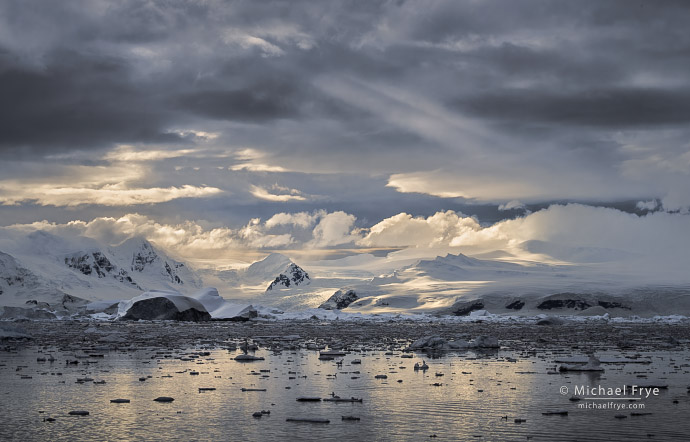
Clouds, sunbeams, and mountains, Antarctica. One of the things that surprised me about Antarctica was how bright it was. I expected some dramatic, even gloomy weather – and we got a little of that. But the days were long; it never got completely dark. And all that ice, snow, and water reflected lots of light, making everything luminous. So some of my favorite landscape images of Antarctica capture a bit of the drama of that incredible place, but also show some of the luminosity.
There’s value in photographing familiar places. Whether it’s somewhere near home, or a spot you visit repeatedly, the better you know an area, the better you’ll be able to know where to go under different conditions. And maybe more importantly, you can forge a deeper connection with that place, and that tends to manifest itself in your photographs.
On the other hand, it’s exciting to travel to new, unfamiliar destinations. We only have so much time on this earth, and most of us would like to see as much of this planet as we can while we’re here – if we have the opportunity to do so.
I’ve been lucky to have teamed up with Justin Black and Visionary Wild to co-lead trips in recent years to some amazing, unforgettable locations like New Zealand, Antarctica, and Hokkaido, Japan. I’ll also be heading to Greenland in September, and rafting down the Grand Canyon again next spring – my third trip down the canyon in the last few years. These trips have all been very different, but I’ve loved them all. They’ve been opportunities to experience some of the wonderful, beautiful diversity of this planet.
On these journeys I’ve faced the challenge of photographing places I’m not familiar with. In some cases I’d never been there before; in other cases, I may have been there, but didn’t know the location very well. It helped immensely, of course, to work with a co-instructor who did know the area well – people like Jerry Dodrill, who’s rafted down the Grand Canyon a dozen times, or Toshiki Nakanishi, who has lived on Hokkaido for 20 years. These are people who do have a deep connection with those places, and it helps to see things through their eyes.
But I can’t photograph things the same way they do. We’re all different, have different ways of seeing, and respond to things differently. That’s one of the things that makes photography so interesting, and so much fun – we could all be standing in the same place at the same time, but be drawn to different subjects and different compositions.
And while it helps to know a place well, there’s also something to be said for seeing things with fresh eyes. Maybe your perspective will bring something new to the location, even if it’s a place that many other photographers have visited. No one sees the world the way you do.
A photographer friend of mine, G Dan Mitchell, never does any research on new locations. He wants to approach them without any preconceptions. That’s a bit too extreme for me; I’d like to know something about an area, if only to maximize my time there. But I do think it helps to approach a new location with an open mind, without preconceived ideas of what it will be like, or what you’ll want to photograph – otherwise you can end up making images of what you think the place should be like, rather than photographs that reflect your own actual experience.
On the other hand, while you might not want to let other people’s photographs of an area influence you too much beforehand, I think it can be valuable to read about a place. Learning about the scientific, cultural, or historical background of an area can give you a deeper understanding of it, and that can make your photographs richer.
Regardless of how much or little research I do beforehand, I try to keep an open mind, and pay attention to my reactions to a place. First, is it what I expected? The answer to that question is usually no. It’s almost never what I expected. Whatever I might have read or seen about a place is only going to give me, at most, a small taste of it. Actually being there in person is always very different, and a much richer experience.
So I try to pay attention to my reactions and impressions – whatever they might be. For instance, one of the things that surprised me about Antarctica was how bright it was. I’d seen many photographs of Antarctica, as I’m sure many of you have. And many of those included some clouds and dramatic weather. As I found out, that’s characteristic; clear, sunny, cloud-free days are rare in Antarctica.
But that doesn’t mean it was gloomy – far from it. Most of the land is covered with ice and snow, reflecting lots of light. And you’re typically viewing Antarctica from a boat, surrounded by water, which also reflects lots of light. Plus, in the Antarctic summer the days are long. In mid-January, when our trip started, it never got truly dark – only dusky.
So Antarctica was certainly dramatic, but also luminous. And I think my favorite photographs of the Antarctic landscape show some of the drama of that incredible, otherworldly landscape, but also some of that luminosity.
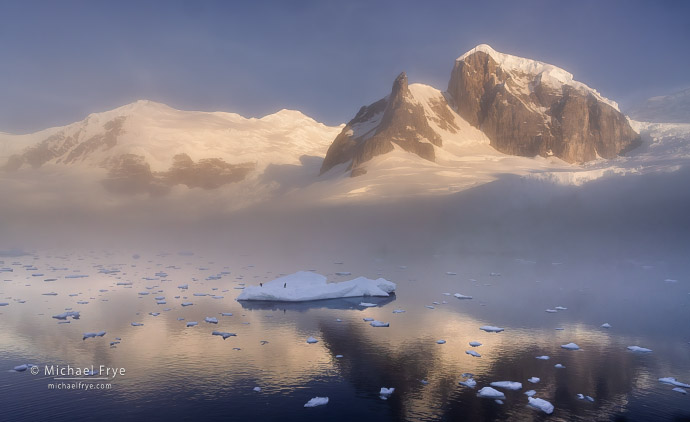
Fog, ice, and mountains, Antarctica. Again, I tried to show some of the grandeur of the Antarctic landscape, but also the luminosity.
While rafting the Grand Canyon, on the other hand, you’re down in the depths of the biggest, deepest canyon in the world. You never see the horizon. But again, the canyon doesn’t seem gloomy to me. There’s light bouncing off the canyon walls, and reflecting in the river. And the river itself feels like a living, breathing entity accompanying you throughout the journey.
The Grand Canyon is one of the most impressive landscapes in the world, with vertical cliffs soaring up from the river in successive steps, all the way to the canyon rim 5,000 feet above. And the river features big, roaring rapids (though interspersed with stretches of long, calm, flat water). The rapids create some intense moments, and the views from the raft are frequently dramatic as well.
On the other hand, you can walk a short distance up a side canyon and find yourself in a different world. It could be perfectly quiet except for the tinkling of a small stream, or the descending trill of a canyon wren. Your focus narrows, and you notice details like a sculptured rock formation, a blooming cactus, or ferns growing out of a small seep. For the moment, the massive canyon fades from your mind, and you become immersed in the delicate beauty around you.
So for me it’s that contrast between the grand and the intimate, the dramatic vistas and the serene side canyons, that make the journey down the canyon so special. And I’ve tried to show that diversity in my photos. It’s one place that, to me, can’t be encapsulated in one photograph, so I’ve attempted to create small portfolios that show the varied beauty and moods of that incredible place.
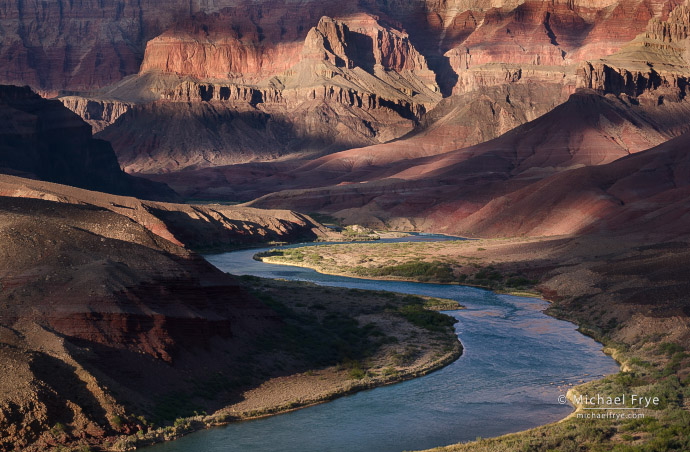
Dappled light along the Colorado River, Grand Canyon NP, Arizona. One of the things that struck me about the Grand Canyon was how the vastness and drama of the main canyon contrasted with the quiet beauty of the side canyons. I’ve tried to make photographs that capture both. Here I tried to show some of that main-canyon drama.
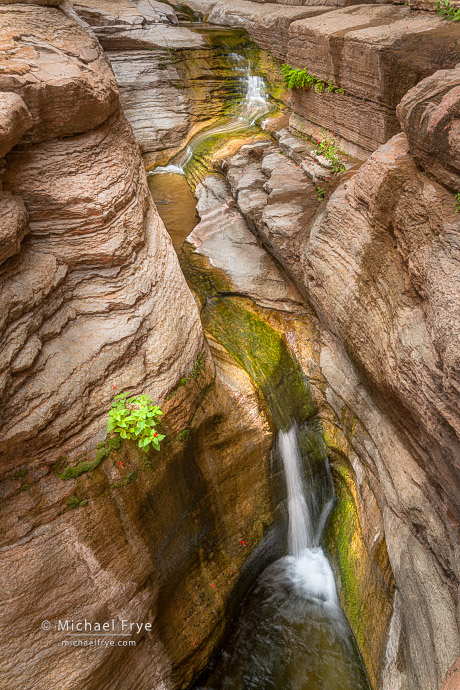
Cascades and monkeyflowers in a limestone canyon, Grand Canyon NP, Arizona. This photograph portrays, I hope, some of the quiet beauty of the side canyons, contrasting with the grandeur of the main canyon.
When you’re photographing a place for the first time it’s easy to be like that dog in the movie Up, whose attention gets hijacked by every squirrel he sees. Everything is new and exciting, and you might see potential photographs everywhere. “Oh, look at that! And look at that!” Which is all fine, and normal.
But I think it’s worth taking a step back periodically to assess your reactions to the place, and your trip. Is it what you expected? (Probably not!) What surprises you? Visually, what strikes you? What’s different, interesting, or eye-catching to you about this place? Emotionally, how does this place make you feel? What kind of mood does the landscape convey to you? And, most importantly, what do you want to say about this place through your photographs?
If you’re like me, your answers to some of those questions might be a little vague at first. But as time goes on you might be able to at least form some partial answers, and get a clearer idea of what kind of photographs you want to make. And then you can be alert for opportunities to make those photographs as you go along.
It’s also likely that your answers will evolve as you travel to different locations, as the weather changes, and as you get to know an area better. That’s all fine – great, in fact. Just keep track of your visual and emotional reactions to everything, so that your photographs can better reflect your evolution.
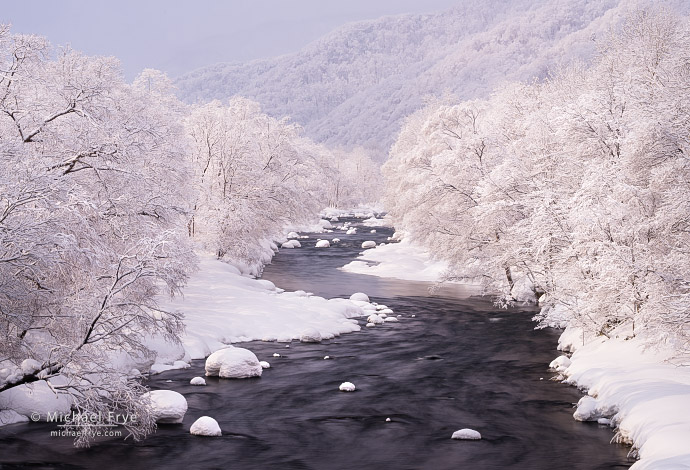
River and snow-covered trees, Hokkaido, Japan. While I made some minimalist landscape images in Hokkaido, in the style of Michael Kenna or Shinzo Maeda, some of my favorite photographs from this island were more complex, like this one. I think it’s important to stay true to yourself, and photograph what appeals to you, wherever you are.
And on a more practical level… when was the last time you picked up your camera? If you’re traveling to someplace you’ve never been before, and may never return to, get out and practice before you go – even if it’s just in your yard or neighborhood. You want to shake off the rust before the trip, not during it. And please resist the urge to buy the latest and greatest camera right before the journey. You don’t want to be figuring out menus and buttons as some great light is fading on your once-in-a-lifetime trip. If you want to get a new camera, make sure you give yourself plenty of time to practice using it before your journey.
I’m going to get another chance to photograph a new location in September, when I’ll be going to Greenland for the first time. I’ll be co-leading this trip for Visionary Wild with Jerry Dodrill and Chris Linder, who have both been to Greenland multiple times. And the ship’s captain and crew aboard the Rembrandt van Rijn know the area even better. So I’m confident they’ll all be able to lead our group to great locations at the right times.
I’ve seen many photos of Greenland, so I have some idea of what I’ll encounter. But I know nothing will prepare me for the actual experience of being there. Greenland will be different than I expected in some ways, or maybe many ways – I just don’t know how it will diverge from my expectations until I get there. But I’ll assess my reactions to the area periodically, and hope those assessments can lead me to make more meaningful, more personal photographs of a place I’ve never been to before. And I’ll help guide our participants – most of whom will also be first-time visitors – to evaluate their own impressions to the area, and make images of Greenland that are meaningful to them. It’ll be a fun challenge!
I’ll also be going back to Antarctica next January, Hokkaido again next February, and rafting down the Grand Canyon again next April. These will be my second visits to Antarctica and Hokkaido, and my fourth trip down the Grand Canyon. I can’t wait to go back to each of these places, because they’re all fantastic.
A repeat visit gives me an opportunity to think back and reassess. What were my impressions of the area the first time? What about that landscape spoke to me? Are there things I’d like to say about that area that I wasn’t able to say the first time?
But I also realize that my reactions won’t be the same the second time. We may go to some new spots, and the weather will almost certainly be different. And I’ll be different. We all change, and grow, and my experience of a place will change even if conditions are exactly the same (which of course never happens). So I’ll need to tune into my reactions again, and make sure my photographs tell the stories I want to tell this time – not just the ones I wanted to tell last time.
It can be a challenge to photograph a place for the first time, but I hope these thoughts help you meet that challenge whenever you go to a new location – whether that’s someplace exotic like Antarctica, or a spot in your home state you’ve never visited before. But I’d also like to hear how you’ve dealt with photographing unfamiliar places. Do you research the area thoroughly, or prefer to go without any preconceived ideas? Have you been able to make photographs of a new, unfamiliar place that expressed your own experience of that place? If so, what helped you do that?
— Michael Frye
P.S. I’d love to have you join me on one of my upcoming Visionary Wild trips to Greenland, Antarctica, Hokkaido, or the Grand Canyon. These are all very different, but all amazing places, wonderful adventures, and rich experiences. My co-instructors and I will be there to help you make the most of your time, and come home with photographs that express your own unique vision of those areas.
And for the Greenland trip this September, Visionary Wild is offering a $2000 discount until June 15th with the code GREENLAND2K2025.
I hope to see you in one of these spectacular locations! We’re going to have so much fun!
Related Posts: One Day in Antarctica; Canyon Moods; Simplicity and Complexity in Hokkaido
Michael Frye is a professional photographer specializing in landscapes and nature. He lives near Yosemite National Park in California, but travels extensively to photograph natural landscapes in the American West and throughout the world.
Michael uses light, weather, and design to make photographs that capture the mood of the landscape, and convey the beauty, power, and mystery of nature. His work has received numerous awards, including the North American Nature Photography Association’s 2023 award for Fine Art in Nature Photography. Mich
ael’s photographs have appeared in publications around the world, and he’s the author and/or principal photographer of several books, including Digital Landscape Photography: In the Footsteps of Ansel Adams and the Great Masters, and The Photographer’s Guide to Yosemite.
Michael loves to share his knowledge of photography through articles, books, workshops, online courses, and his blog. He’s taught over 200 workshops focused on landscape photography, night photography, digital image processing, and printing.

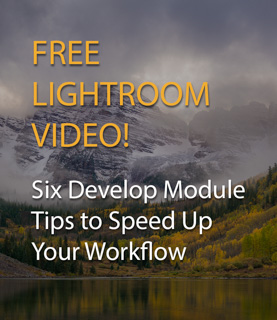





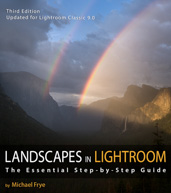
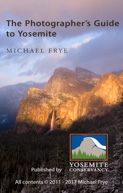
Beautiful photos. Thanks for sharing.
Thank you Vladimir!
Michael,
I read this post with interest — and not only because you mentioned my slightly iconoclastic notion about avoiding too much knowledge of a place before I visit. (I have a few humorous stories that have resulted from that practice… and I really need to write about them at my blog at some point — perhaps when we return from our current travels.)
You, on the other hand, seem to me to be one of the most prepared and knowledgeable photographers I know. You are typically a font of information about any location that I’ve heard you talk about or where I’ve had the good fortune to photograph with you.
To flesh out my thinking about this “preparation” question just a little bit (yes, a longer post at my blog will come eventually), I think I’m actually somewhat binary about place/subject knowledge issue. I have two distinct approaches that seem to lie at opposite ends of the spectrum.
At one end is the approach I take when I visit new places. I want to go with few preconceptions and an openness to discovery. I don’t want to see it as others have, but rather as I do. I literally go out and wander sometimes. (I’ve been doing that for the past few weeks, and I’ll have more to share about that in coming weeks and months.)
At the other end is my practice of returning to familiar places I have photographed many times before — sometimes for decades. These places are like old friends whose ins and outs and personality quirks I know well, yet about whom I continue discover new things.
Both approaches work, I think, along with others along that spectrum.
Dan
Thanks for chiming in Dan! I figured you would. 🙂 It’s always interesting to hear about your approaches to this.
By the way, “Cascade and Monkeyflowers” is really lovely!
Thanks Dan!
All magnificent, but I particularly love the Antarctica image. That light–I missed it, sigh.
Thanks DJ! Sorry you missed that light. It was hard to be out there all the time. But you made some great photos down there!
Great stuff as usual, Michael! One thing I might add: photographing unfamiliar places is itself a skill one can practice, and you don’t have to fly across the world to do it. Most of us probably have reasonable access to less famous parks, preserves, refuges, trails, etc, and showing up at those locations and working with what you find is great practice for when you do make the big journey.
It’s also satisfying to me that you relate this to the Grand Canyon. I started my photo journey in my river guiding days (largely Idaho, plus some Canyon trips), and because we never knew in advance exactly where we’d be camping, it didn’t pay off to overthink precise location details. I’d show up at camp and work with what was there. I didn’t exactly plan it, but I’m really glad that I got my start that way – photographing unfamiliar locations has always been kinda my default, and honestly it’s a great way to work.
Good points Jackson – thanks for chiming in! On your river trips, even though a specific camp might have been new to you, you were familiar with the canyon or river in a general sense, and I think that helps. You had a sense of what the light might do, and what kinds of photos might work. More importantly, you had a connection with the place, an appreciation for the area on a deeper level than if it was your first time down that stretch of river, and that’s bound to come through in your photographs.
Wonderful, insightful post, Michael. Not to mention the photographs. 🙂 I am pretty aligned with your thoughts – not wanting to look at too much visual material beforehand, but reading a lot to build up some understanding and background. It’s downright impossible to NOT see images, however, to the iconic places you have been to this year so far. Yet I know that your individual eye will see it in ways others won’t and you will make great photographs in Greenland too.
Thanks Brenda! You’re right in that it’s impossible not to see images from certain places. You hope that you can avoid being too influenced by those images, and still see things in your own way.